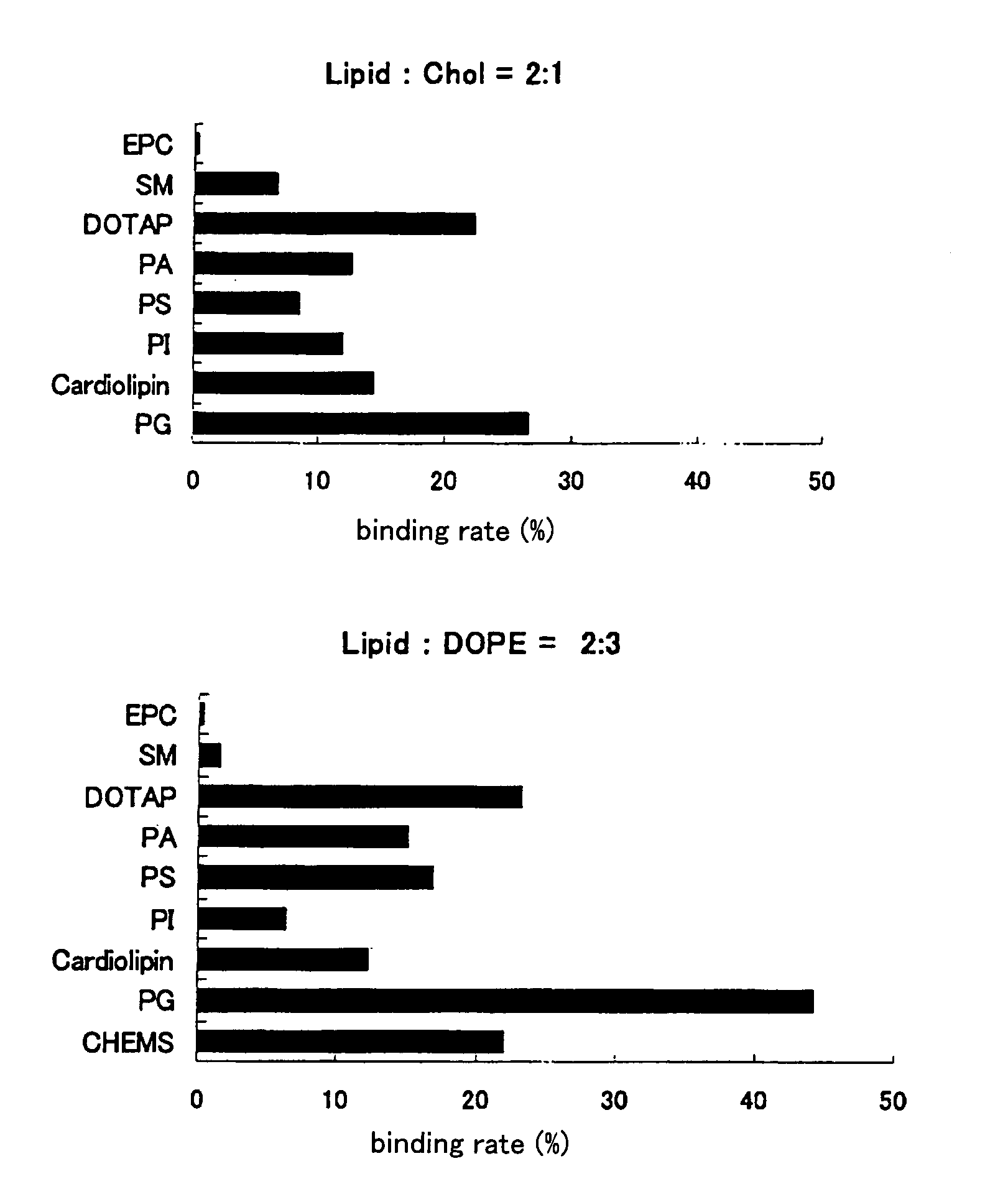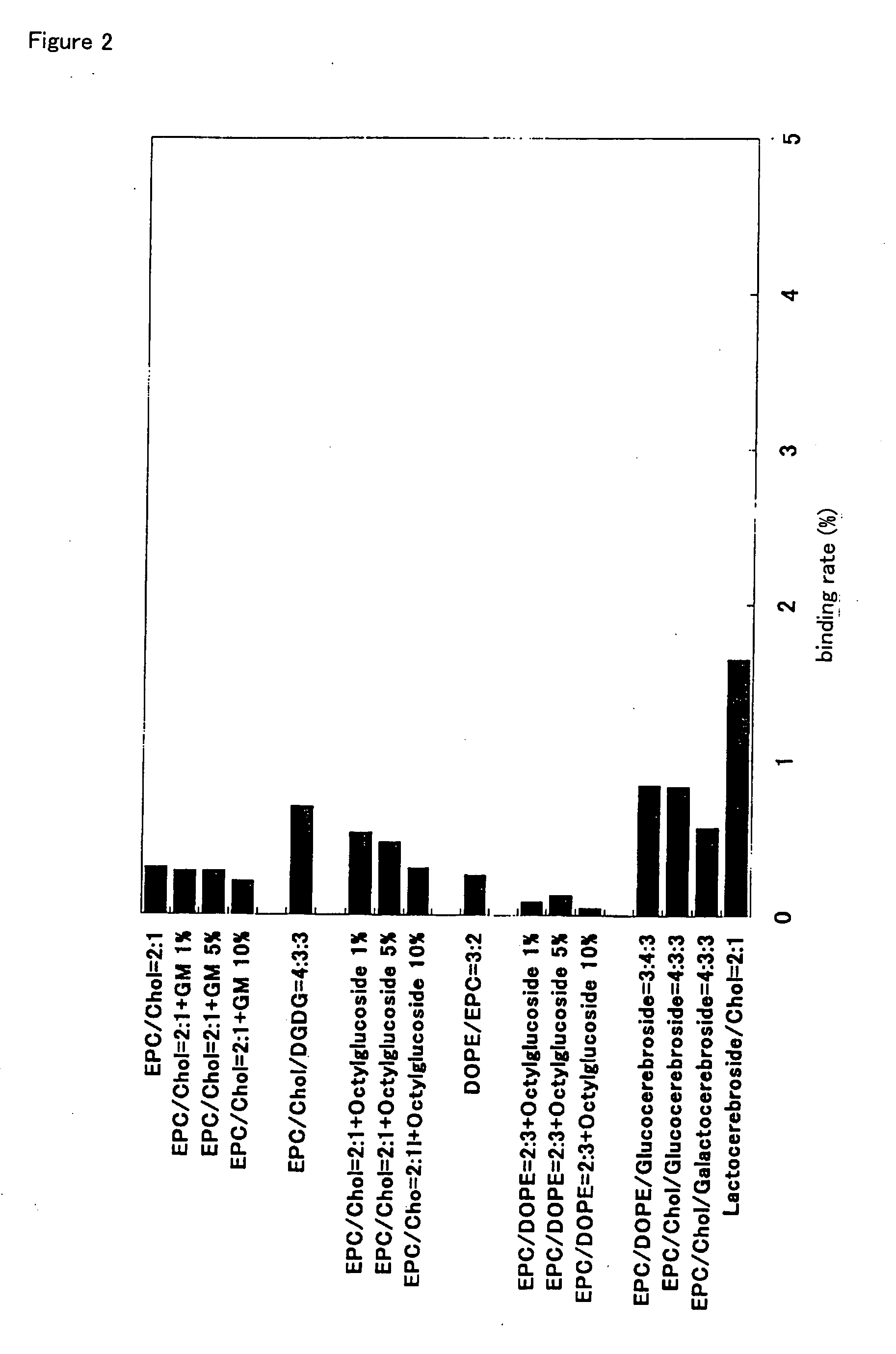Vector For Delivering Target Substance Into Nucleus or Cell
a target substance and nucleus technology, applied in the field of vectors for delivering target substances into nuclei or cells, can solve the problems of difficult mass production, antigenicity, toxicity, etc., and achieve the effect of efficiently delivering genes into nuclei
- Summary
- Abstract
- Description
- Claims
- Application Information
AI Technical Summary
Benefits of technology
Problems solved by technology
Method used
Image
Examples
example 1
Screening of Lipids to Find Those Having Ability to Fuse with Nuclear Membranes
[0151]1. Establishment of Method for Isolating Nuclei and Experimental System for Assaying Ability of Lipids to Bind to Nuclear Membranes
[0152]1-1. Introduction
[0153]The ability of lipids to bind to nuclear membranes is an essential factor to evaluate their ability to fuse with nuclear membranes. Therefore, in the first step of screening of lipids to find those having the ability to fuse with nuclear membranes, the ability of lipids to bind to nuclear membranes was evaluated. Since it has been reported that lipids such as PA and PS are fused with nuclear membrane (R. Lawaczeck.: Intraction of negatively charged liposomes with nuclear membranes: adsorption, lipid mixing and lysis of the vesicles. Biochem. Biophys. Acta. 903 (1987) 123-131), attention was focused on charged lipids, especially negatively-charged lipids in the following examples. Further, since it has been reported that a sugar chain has an a...
example 2
Screening of Lipids Having Ability to Fuse with Nuclear Membranes
[0251]1. Screening Using FRET
[0252]1-1. Preparation of Membrane-Labeled Liposomes
[0253](1) DOPE:Lipid=9:2
[0254]1 mM DOPE and a 1 mM lipid stock were mixed in a mole ratio of 9:2, and a CHCl3 solution containing NBD-DOPE in an amount of 1 mol % of the total lipid concentration and a CHCl3 solution containing Rho-DOPE in an amount of 0.5 mol % of the total lipid concentration were added thereto, and CHCl3 was further added thereto. The thus obtained mixture was dried in an atmosphere of nitrogen gas to prepare lipid film. Then, 10 mM HEPES buffer as an internal aqueous phase was added to the lipid film so that the total lipid concentration became 0.55 mM to hydrate the lipid film. Then, ultrasonic treatment was carried out to prepare liposomes.
[0255](2) DOPE:Lipid=5:5
[0256]1 mM DOPE and a 1 mM lipid stock were mixed in a mole ratio of 5:5, and a CHCl3 solution containing NBD-DOPE in an amount of 1 mol % of the total lipi...
example 3
Screening of Lipids to Find Endosomal Escape-Promoting Lipids
[0271]In a case where a liposome containing two kinds of fluorescent pigments (NBD and Rhodamine) in its lipid membrane is present alone and the fluorescence spectrum of one of the fluorescent pigments and the excitation spectrum of the other fluorescent pigment are overlapped, the fluorescence of NBD is not usually observed even when NBD is irradiated with light having the excitation wavelength of NBD (this is because when NBD and Rhodamine coexist adjacent to each other, the fluorescence energy of NBD is used to excite Rhodamine; and this phenomenon is called “FRET” (Fluorescence Resonance Energy Transfer). When such a liposome is fused with another lipid membrane (e.g., cell membrane), the liposomal lipid is diluted with the lipid membrane as a receiver so that the distance between NBD and Rhodamine contained in the liposomal membrane is increased, and therefore a phenomenon called FRET is cancelled. Utilizing such a ph...
PUM
| Property | Measurement | Unit |
|---|---|---|
| particle size | aaaaa | aaaaa |
| particle size | aaaaa | aaaaa |
| thickness | aaaaa | aaaaa |
Abstract
Description
Claims
Application Information
 Login to View More
Login to View More - R&D
- Intellectual Property
- Life Sciences
- Materials
- Tech Scout
- Unparalleled Data Quality
- Higher Quality Content
- 60% Fewer Hallucinations
Browse by: Latest US Patents, China's latest patents, Technical Efficacy Thesaurus, Application Domain, Technology Topic, Popular Technical Reports.
© 2025 PatSnap. All rights reserved.Legal|Privacy policy|Modern Slavery Act Transparency Statement|Sitemap|About US| Contact US: help@patsnap.com



